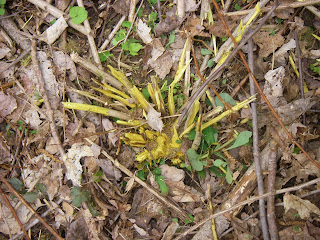 |
Red Eft Life Stage of the Red-spotted Newt
photo by James Fischer |
We revisited the cover-board experiment grid and observed a few interesting patterns. Faye Curran, a new student intern, helped us today with this project, please visit the blog in a couple days to read her introduction. Recently, we have recorded almost 14 inches of rain from Hurricane/Tropical Storm Irene and Tropical Storm Lee. Although most of the surface run-off has slowed, there is still quite a bit of water in the forest percolating into the soil column from vernal pools or bubbling out of springs. The amphibian cover-boards encounter rate appears to have been affected by all of this precipitation. A total of 65 of the 132 cover-board stations detected an amphibian, which is the second highest percentage of cover-board stations detecting amphibians since the project started 2.5 years ago. We encountered a total of 79 Redback Salamander (
Plethodon cinereus), 19 Red Eft (
Notophthalmus viridescens), 2 Two-lined Salamander (
Eurycea bislineata), 1 Four-toed Salamander (
Hemidactylium scutatum), and 1 Wood Frog (
Rana sylvatica). The primary question of this project is to examine the differences between softwood and hardwood cover-boards amphibian detection rates using a pair-wise comparison experiment. The softwood cover-boards detected a total of 57, while the hardwood boards detected 45 individuals.





























